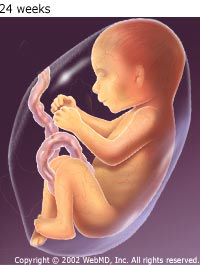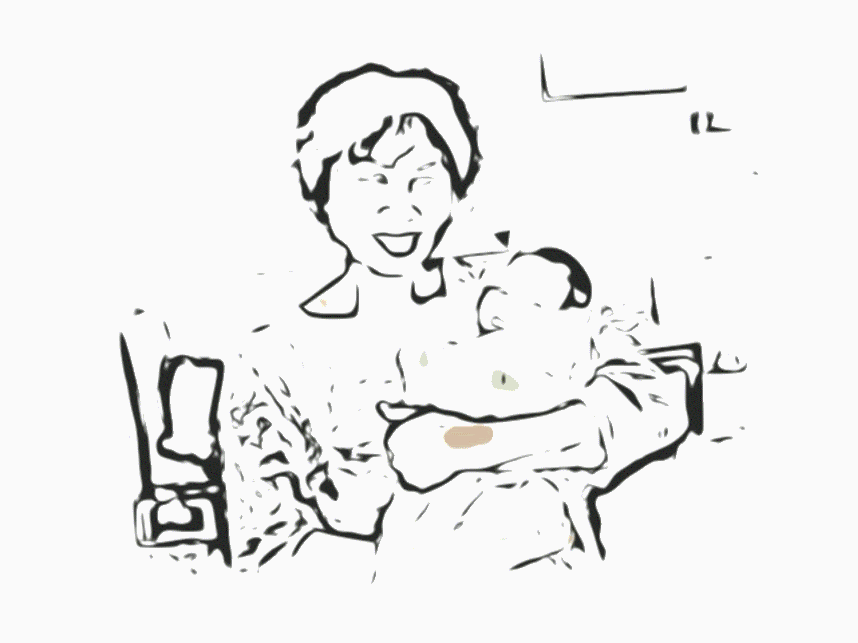
Second Trimester Tests During Pregnancy
Here are the prenatal tests you may face in the second trimester of your
pregnancy:
Maternal serum alpha-fetoprotein (MSAFP) and multiple marker
screening: One or the other is offered routinely in the second
trimester. The MSAFP test measures the level of alpha-fetoprotein, a protein
produced by the fetus. Abnormal levels indicate the possibility (but not
existence) of Down syndrome or a neural tube
defect such as spina bifida, which can then be confirmed by ultrasound or
amniocentesis.
When blood drawn for the MSAFP test is also used to check levels of the
hormones estriol and hCG, it's called the triple test. When a marker called
inhibin-A is added to the screen, it is known as the quad marker. The quad
marker test significantly boosts the detection rates for Down syndrome. The
test picks up about 75% of neural tube defects and 75%-90% of Down syndrome
cases (depending on the mother's age), but many women will have a
false-positive screening. About 3% to 5% of women who have the screening test
will have an abnormal reading, but only a small percentage of those women will
actually have a child with a genetic problem.
Ultrasounds: Ultrasounds (sonograms) are commonly offered
around the 20 week, although they may be done at any time during a pregnancy. A
sonogram may be offered for a variety of reasons, including verifying a due
date, checking for multiple fetuses, investigating complications such as placenta previa (a low-lying
placenta) or slow fetal growth, or detecting malformations like cleft palate.
During the procedure, a device is moved across the abdomen that transmits sound
waves to create an image of the uterus and fetus on a computer monitor. New
three-dimensional sonograms provide an even clearer picture of your baby, but
they aren't available everywhere and it's not clear whether they're any better
than two-dimensional pictures in contributing to a healthy pregnancy or
birth.
Glucose screening: Typically done at 24 to 28 weeks, this
is a routine test for pregnancy-induced diabetes, which can result in overly
large babies, difficult deliveries, and health problems for you and your baby.
This test measures your blood-sugar level an hour after you've had a glass of a
special soda. If the reading is high, you'll take a more sensitive
glucose-tolerance test, in which you drink a glucose solution on an empty
stomach and have your blood drawn every hour for 2-3 hours.
Amniocentesis: This optional test is usually performed
between 15 and 18 weeks of pregnancy (but can be done earlier) for women who
are 35 or older, have a higher-than-usual risk of genetic disorders, or whose
MSAFP or multiple marker test results were suspicious. The procedure is done by
inserting a needle through the abdomen into the amniotic sac and withdrawing
fluid that contains fetal cells. Analysis can detect neural tube defects and
genetic disorders. The miscarriage rate after amniocentesis varies depending on
the experience of the physician, averaging about 0.2% to 0.5% at 15 weeks, but
the test can detect 99% of neural tube defects and almost 100% of certain
genetic abnormalities.
Cordocentesis: Cordocentesis, also known as fetal blood sampling
(FBS) or percutaneous umbilical cord sampling, collects fetal blood directly
from the umbilical cord or fetus. This test can be used to measure anemia and
blood oxygen levels and to screen for maternal Rh antibodies. Cordocentesis can
be done as early as the 17th week of pregnancy.
Fetal Doppler ultrasound: A
Doppler ultrasound test uses soundwaves to evaluate blood as it flows through a
blood vessel. Fetal Doppler ultrasound can determine if blood flow to the
placenta and fetus is normal.
Fetoscopy: Fetoscopy allows a doctor to see the fetus
through a thin, flexible instrument called a fetoscope. Fetoscopy can detect
some diseases or defects that cannot be found by other tests, such as
amniocentesis, ultrasound, or chorionic villus sampling.
Because fetoscopy carries significant risks for the mother and fetus, it is an
uncommon procedure that is only recommended if there is a much
higher-than-normal chance that the baby will have an abnormality.
The Second Trimester: Your Baby's Growth and Development in Middle Pregnancy
Month 4 of Pregnancy
Your baby's fingers and toes are well-defined; eyelids,
eyebrows, eyelashes, nails, and hair are formed. Teeth and bones become denser
in the second trimester of pregnancy. Your baby can even suck his or her thumb,
yawn, stretch, and make faces.
The nervous system is starting to function at this point in
pregnancy. The reproductive organs and genitalia are now fully developed, and
your health care provider can see on
ultrasound if you are having a boy or a girl. Your baby's heartbeat may now
be audible through an instrument called a Doppler.
By the end of the fourth month, your baby is about 6 inches
long and weighs about 4 ounces.

Month 5 of Pregnancy
Hair is beginning to grow on your baby's head and lanugo, a
soft fine hair, covers his or her shoulders, back, and temples. This hair
protects your baby and is usually shed at the end of the baby's first week of
life.
Your baby's skin is covered with a whitish
coating called vernix caseosa. This "cheesy" substance, thought to protect
baby's skin from long exposure to the amniotic fluid, is shed just before birth.
You may begin to feel your baby move, since he or she is
developing muscles and exercising them. This first movement is called
quickening.
By the end of the fifth month of pregnancy, your baby is about
10 inches long and weighs from 1/2 to 1 pound.
Now that you've read about your baby's development in the first
20 weeks of pregnancy,
take this quiz to test your smarts!

Month 6 of Pregnancy
By the end of the sixth month, your baby is about 12 inches
long and weighs about 2 pounds. His or her skin is reddish in color, wrinkled,
and veins are visible through the baby's translucent skin. Baby's finger and
toe prints are visible. The eyelids begin to part and the eyes open.
Your baby may respond to sounds by moving or increasing the
pulse, and you may notice jerking motions if baby hiccups.
If born prematurely, your baby may survive after the
23rd week of pregnancy with intensive care.

Third Trimester Tests During Pregnancy
These tests are common in the third trimester of pregnancy:
Group B streptococcus screening: Vaginal and rectal swabs
are taken at 35 to 37 weeks of pregnancy to detect group B strep bacteria.
Although group B strep can be present in up to 30% of all healthy women, it's
the leading cause of life-threatening infections in newborns and can also cause
mental retardation, impaired vision, and hearing loss. Women who test positive
are treated with antibiotics during delivery to protect the baby from
contracting the infection at birth. As an alternative, your physician or
midwife may choose not to test for strep but to treat you in labor if certain
risk factors develop.
Electronic fetal heart monitoring: Electronic fetal heart
monitoring is done during pregnancy, labor, and delivery to monitor the heart
rate of the fetus. The fetal heart rate can indicate whether the fetus is doing
well or is in trouble and can be done any time after 20 weeks.
Nonstress test: Done weekly in many high-risk pregnancies,
such as women with twins, diabetes, or high blood pressure, this test involves
using a fetal monitor strapped across the mother's abdomen to measure the
baby's heart rate as it moves. It's also used for monitoring overdue
babies.
Contraction stress test: Also done in high-risk
pregnancies, a fetal monitor measures the baby's heart rate in response to
contractions stimulated either by oxytocin (Pitocin) or nipple stimulation.
Doctors use the measurements to predict how well the baby will cope with the
stress of labor.
Biophysical profile: Combines a nonstress test with an
ultrasound for a more accurate evaluation of the baby.
Third Trimester of Pregnancy
Now that you've reached the third trimester, you're in the home stretch of your pregnancy. You've only got a few more weeks to go, but
this part of your pregnancy can be the most challenging. Not only are you
lugging around a lot of extra weight (25-35 pounds by the time you deliver), but
you're also dealing with a variety of uncomfortable symptoms.
In this article, you'll learn what to expect during your third trimester of
pregnancy. You'll find out which symptoms are perfectly normal, and which ones
are serious enough to warrant a call to your doctor.
Changes in Your Body
Backache. The extra weight you've gained is putting added pressure on
your back, making it feel achy and sore. You might also feel discomfort in your
pelvis and hips as your ligaments loosen to prepare for labor. To ease the
pressure on your back, practice good posture. Sit up straight and use a chair
that provides good back support. At night, sleep on your side with a pillow
tucked between your legs. Wear low-heeled, comfortable shoes with good arch
support. To relieve back pain, use a heating pad and ask your doctor whether
it's OK for you to take acetaminophen.
Bleeding. Spotting may be a sign of a serious problem, including placenta previa (the placenta grows low and covers the
cervix), placental abruption (separation of the placenta from the uterine
wall), or preterm labor. Call your doctor as soon as you notice
any bleeding.
Braxton Hicks
contractions. You might
start to feel mild contractions, which are warm-ups to prepare your uterus for
the real labor to come. Braxton Hicks contractions often aren't as intense as
real labor contractions, but they may feel a lot like labor and can eventually
progress to it. One main difference is that real contractions gradually get
closer and closer together -- and more intense. If you're red in the face and
out of breath after your contractions, or they're coming regularly, call your
doctor.
Breast enlargement. By the end of your pregnancy, your breasts will
have grown by as much as 2 pounds. Make sure you're wearing a supportive bra so
your back doesn't suffer. Close to your due date, you may start to see a
yellowish fluid leaking from your nipples. This substance, called colostrum,
will nourish your baby in the first few days after birth.
Discharge. You might see an increased amount of vaginal discharge during the third trimester. If the
flow is heavy enough to soak through your panty liners, call your doctor. Close
to your delivery date, you might see a thick, clear, or slightly blood-tinged
discharge. This is your mucus plug, and it's a sign that your cervix has begun
dilating in preparation for labor. If you experience a sudden rush of fluid, it
may mean that your water has broken (although only about 8% of pregnant women
have their water break before contractions begin). Call your doctor as soon as
possible after your water breaks.
Fatigue. You might have been feeling energetic in your second
trimester, but now the extreme weariness is back. Carrying extra weight, waking
up several times during the night to go to the bathroom, and dealing with the
anxiety of preparing for a baby can all take a toll on your energy level. Eat
healthy food and get regular exercise to give yourself a boost. When you feel
tired, try to take a nap, or at least sit down and relax for a few minutes. You
need to reserve all your strength now for when your baby arrives and you're
really not getting any sleep.
Frequent urination
. Now that your baby is bigger,
the baby's head may be pressing down on your bladder. That extra pressure means
you'll have to go to the bathroom more frequently -- including several times
each night. You might also find that you're leaking urine when you cough,
sneeze, laugh, or exercise. To relieve the pressure and prevent leakage, go to
the bathroom whenever you feel the urge and urinate completely each time. Avoid
drinking fluids right before bedtime to cut down on unwanted late-night
bathroom visits. Wear a panty liner to absorb any leakage that does occur. Let
your doctor know if you experience any pain or burning with urination. These
can be signs of a urinary tract infection.
Heartburn and constipation. Uncomfortable gastrointestinal symptoms
like heartburn and constipation can pester you throughout your pregnancy.
They're caused by extra production of the hormone progesterone, which relaxes
smooth muscles -- including the muscles in your esophagus that normally keep
food and acids down in your stomach, and the ones that move digested food
through your intestines. To relieve heartburn, try eating more frequent,
smaller meals throughout the day and avoid greasy, spicy, and acidic foods
(like citrus fruits). For constipation, increase your fiber intake and drink
extra fluids to keep things moving more smoothly. If your heartburn or
constipation is really bothering you, talk to your doctor about what
medications may be safe for you to take for symptom relief.
Hemorrhoids. Hemorrhoids are actually varicose veins -- swollen veins that form around the
anus. These veins enlarge during pregnancy because extra blood is flowing
through them and the weight of pregnancy increases the amount of pressure to
the area. To relieve the itch and discomfort, try sitting in a warm tub or sitz
bath. Ask your doctor whether you can also try an over-the-counter hemorrhoid
ointment or stool softener.
Shortness of breath. As your uterus expands, it rises up until it
sits just under your rib cage, leaving less room for your lungs to expand. That
added pressure on your lungs can make it more difficult to breathe. Exercising
can help with shortness of breath. You can also try propping up your head and
shoulders with pillows while you sleep.
Spider and varicose veins. Your circulation has increased to send
extra blood to your growing baby. That excess blood flow can cause tiny red
veins, known as spider veins, to appear on your skin. Spider veins may get
worse in your third trimester, but they should fade once your baby is born.
Pressure on your legs from your growing baby may also cause some surface veins
in your legs to become swollen and blue or purple. These are called varicose
veins. Although there's no way to avoid varicose veins, you can prevent them
from getting worse by getting up and moving throughout the day, wearing support
hose, and propping up your legs whenever you have to sit for long periods of
time. Varicose veins should improve within a few months after you
deliver.
Swelling. Your rings might be feeling tighter these days, and you may
also notice that your ankles and face are looking bloated. Mild swelling is the
result of excess fluid retention (edema). To reduce swelling, put your
feet up on a stool or box whenever you sit for any length of time, and elevate
your feet while you sleep. If you have sudden onset of swelling though, seek
medical attention immediately as it may be a sign of preeclampsia, a dangerous
pregnancy complication.
Weight gain. Aim for a weight gain of 1/2 pound to 1 pound a week
during your third trimester. By the end of your pregnancy, you should have put
on a total of about 25 to 35 pounds (your doctor may have recommended that you
gain more or less weight if you started out your pregnancy underweight or
overweight). The extra pounds you've put on are made up of the baby's weight,
plus the placenta, amniotic fluid, increased blood and fluid volume, and
added breast tissue. If your baby seems to be too small or too big based on the
size of your belly, your doctor will do an ultrasound to check his growth.
Red Flag Symptoms
Any of these symptoms could be a sign that something is wrong with your
pregnancy. Don't wait for your regular prenatal visit to talk about it. Call
your doctor right away if you experience:
- Severe abdominal pain or cramps
- Severe nausea or vomiting
- Bleeding
- Severe dizziness
- Pain or burning during urination
- Rapid weight gain (more than 6.5 pounds per month) or too little weight gain
Your Pregnancy Week by Week: Weeks 13-16
Week 13
Baby: Your fully formed fetus, now in about its 11th week of
development, measures 2.6 to 3.1 inches from crown to rump and weighs between
half an ounce and seven-tenths of an ounce -- about the size of a peach. The
head is still disproportionately bigger than the body, but the rest of the body
is starting to catch up. In fact, your baby is growing rapidly these days. The
face is starting to look more human, with eyes moving closer together. Toes and
fingers are clearly separate, and ankles and wrists have formed. External
genitalia are becoming visible. Intestines are shifting into their proper
place, too.
Mom-to-be: Your uterus has grown a lot. It's filling your pelvis now
and starting to grow upward into your abdomen. It probably feels like a soft,
smooth ball. If you haven't put on any weight yet because of morning sickness,
you'll begin to now as you start to feel better.
Tip for the Week: It's easy for your partner to feel left out of the
pregnancy since he isn't feeling the same physical changes that you are. Both
of you should share your excitement about having a child, your dreams, worries
and your partner's level of involvement. Suggest that your partner goes to a
check-up with you to hear the baby's heartbeat.
Week 14
Baby: Your baby measures about 3.2 to 4.1 inches from crown to rump
now and weighs almost an ounce. The ears are shifting from the neck to the
sides of the head, and the neck is getting longer and chin more prominent.
Facial features and unique fingerprints are all there. Your baby is beginning
to respond to outside stimuli. If your abdomen is poked, the fetus will try to
wriggle away.
Mom-to-be: You're probably wearing maternity clothes now. Your
skin and muscles are starting to stretch to accommodate your growing baby. You
may notice some constipation because pregnancy hormones relax the bowel.
Tip of the Week: Try to alleviate constipation with moderate
exercise, and by drinking plenty of fluids and eating lots of fruit and
vegetables, preferably raw.
Week 15
Baby: Your 13-week-old fetus now measures about 4.1 to 4.5 inches
from crown to rump and weighs about 1.75 ounces. Its body is covered by an
ultrafine hair, called lanugo, which is usually shed by birth. Eyebrows and
hair on the top of the head are beginning to grow. He may even be sucking his
thumb by now. Bones are getting harder.
Mom-to-be: Your uterus can probably be felt about 3 to 4 inches below
your navel. Sometime in the next five weeks you'll be offered a quadruple
marker screening test, which measures four chemicals in your blood --
alpha-fetoprotein (AFP), human chorionic gonadotropin (hCG), inhibin A, and
estrogen produced by the placenta. The test is a more accurate predictor of
Down syndrome than AFP testing alone. Amniocentesis, which tests a small sample
of amniotic fluid withdrawn by an ultrasound-guided needle, is usually
performed between now and 18 weeks. It may be recommended if you're 35 or older
or if your AFP or quadruple marker screen test results were suspicious.
Tip of the Week: Start learning to sleep on your left side because
circulation is best that way. Lying on your back or stomach after about the
fourth or fifth month can put extra pressure on your growing uterus and
decrease circulation to your baby. You can try tucking pillows behind you and
between your legs. Some manufacturers make a pregnancy pillow that supports
your entire body.
Week 16
Baby: Your baby now measures about 4.3 to 4.6 inches from crown to
rump and weighs about 2.8 ounces. Fingernails are well-formed and the fine
hair, lanugo, may be growing on the head. Arms and legs are moving. The nervous
system is functioning and muscles are responding to stimulation from your
baby's brain. You may be able to hear the baby's heartbeat in the doctor's
office.
Mom-to-be: Your uterus has grown significantly by now and weighs
about 8.75 ounces. Within the next few weeks you may start to feel your baby
move, called "quickening." It's often like a gas bubble or subtle fluttering
movement. As it happens more regularly, you'll know it's your baby. There are
other physiological changes happening in your body. Increased blood volume to
support your growing fetus may produce nosebleeds, and leg veins may become
more apparent. Your uterus is shifting so you may not have to urinate so
much.
Tip of the Week: If veins in your legs are beginning to bulge, you
may want to use support stockings, elevate your feet when you can and exercise
to improve blood flow.
What's Happening Inside You?
Your baby's fingers and toes are well-defined; eyelids, eyebrows, eyelashes,
nails and hair are formed. Teeth and bones become denser. Your baby can even
suck his or her thumb, yawn, stretch and make faces.
The nervous system is starting to function. The reproductive organs and
genitalia are now fully developed, and your health care provider can see on
ultrasound if you are having a boy or a girl. Your baby's heartbeat may now be
audible through an instrument called a Doppler.
By the end of the fourth month, your baby is about 6 inches long and weighs
about 4 ounces.
Your Pregnancy Week by Week: Weeks 17-20
Week 17
Baby:Your baby, now about in its 15th week of development, measures
about 4.4 to 4.8 inches from crown to rump and has doubled in weight in the
last two weeks to about 3.5 ounces. Fat begins to form, helping your baby's
heat production and metabolism. The lungs are beginning to exhale amniotic
fluid, and the circulatory and urinary systems are working. Hair on head,
eyebrows and eyelashes is filling in.
Mom-to-be: You're showing more now, with an obvious swelling in your
lower abdomen. A five- to 10-pound weight gain is typical by now. You also may
be noticing an increase in appetite.
Tip of the Week: Change positions slowly, especially when you move
from a lying down position to sitting or from a sitting position to standing to
avoid feeling dizzy or faint. If you feel lightheaded, sit down and lower your
head, or lie down for a moment.
Week 18
Baby: Your baby measures 5 to 5.6 inches from crown to rump and
weighs about 5.25 ounces. The rapid growth spurt is tapering off, but reflexes
are kicking in. It can yawn, stretch and make facial expressions, even frown.
Taste buds are beginning to develop and can distinguish sweet from bitter
tastes. The baby will suck if its lips are stroked and it can swallow, and even
get the hiccups. The retinas have become sensitive to light, so if a bright
light is shined on your abdomen, baby will probably move to shield its
eyes.
Mom-to-be: Your uterus, about the size of a cantaloupe, can probably
be felt just below your navel. You're most likely feeling the baby move by now.
A mid-pregnancy ultrasound may be performed between now and 22 weeks to assess
fetal growth and development and to verify the due date. If the baby is in the
right position, the ultrasound may even be able to determine whether it's a boy
or a girl. Your heart has to work 40 percent to 50 percent harder now to
support your pregnancy.
Tip for the Week: Suggest that your partner go with you for the
ultrasound. It's a chance to catch the first glimpse of your baby together, as
well as provide a snapshot to show friends and family later. Sonograms still
don't guarantee a healthy baby, but they can provide reassurance and spot some
problems.
Week 19
Baby: Your baby measures about 5.2 to 6 inches from crown to rump and
weighs about 7 ounces. Skin is developing and transparent, appearing red
because blood vessels are visible through it. Creamy white protective coating,
called vernix, begins to develop.
Mom-to-be: As your baby continues to grow, you may be feeling some
mid-pregnancy aches and pains by now -- lower abdominal achiness, dizziness,
heartburn, constipation, leg cramps, mild swelling of ankles and feet, and a
backache. Dilated blood vessels might cause tiny, temporary red marks (called
spider nevi) on your face, shoulders and arms.
Tip of the Week: Take care not to get overtired since rapid growth of
the baby can compound the burden on your heart, lungs and kidneys.
Week 20
Baby: The fetus measures about 5.6 to 6.4 inches from crown to rump
and weighs about 9 ounces. Your baby can hear sounds by now -- your voice,
heart and your stomach growling, as well as sounds outside your body. It will
cover its ears with its hands if a loud sound is made near you, and it may even
become startled and "jump." The baby is moving often, too -- twisting, turning,
wiggling, punching and kicking.
Mom-to-be: Congratulations! You're at about the midpoint of your
pregnancy. Your uterus is just about even with your navel. Your waistline has
pretty much disappeared, but only temporarily! The risk of bladder infections
increases because the smooth muscles in the urinary tract relax. Your breathing
will become deeper and you may perspire more than usual from a more active
thyroid gland.
Tip of the Week: To alleviate backaches, maintain good posture. Sit
with a footstool or use an ergonomic chair at the office, avoid standing for
too long, sleep with a small pillow under your side at the waist, and lift
things with your legs instead of your back.
What's Happening Inside You?
Hair is beginning to grow on your baby's head and lanugo, a soft fine hair,
covers his or her shoulders, back, and temples. This hair protects your baby
and is usually shed at the end of the baby's first week of life.

Your baby's skin is covered with a whitish coating called vernix caseosa.
This "cheesy" substance, thought to protect baby's skin from long exposure to
the amniotic fluid, is shed just before birth.
You may begin to feel your baby move, since he or she is developing muscles
and exercising them. This first movement is called quickening.
By the end of the fifth month, your baby is about 10 inches long and weighs
from 1/2 to 1 pound.
Your Pregnancy Week by Week: Weeks 21-25
Week 21
Baby: Your baby measures about 7.2 inches from crown to rump and
weighs about 10.5 ounces. The fetus is steadily gaining fat to keep warm.
Growth rate is slowing down but organ systems, like digestion, are continuing
to mature. A waxy film, called the vernix caseosa, is being produced by your
baby's oil glands and covers the skin to keep it supple in the amniotic fluid.
Buds for permanent teeth are beginning to form.
Mom-to-be: Friends, relatives, even strangers can probably tell
you're pregnant by now. Your uterus is starting to extend above your navel.
You've probably gained between 10 and 14 pounds by now.
Week 22
Baby: Your baby measures about 7.6 inches and weighs about 12.3
ounces. The muscles are getting stronger every week now, and the eyelids and
eyebrows are developed. Your baby's acrobatics are pretty constant, and since
he responds to sound, rhythm and melody, you can try singing and talking to
him. After he's born, the same sounds will soothe him.
Mom-to-be: Your uterus is continuing to grow, but you're probably
feeling pretty good -- no more morning sickness, and your abdomen isn't so
large that it's getting in the way very much. You may still be getting leg and
foot cramps, as well as mild swelling of ankles and feet.
Tip for the Week: To reduce cramping, increase your intake of calcium
and potassium. Have a glass of milk before bedtime or snack on potassium-rich
foods, such as grapefruits, oranges and bananas. If you do get a leg cramp, try
forcing your toes back toward your face and pushing down on the knee to
straighten your leg.
Week 23
Baby: Your baby is about 8 inches from crown to rump and weighs
almost 1 pound. The body is becoming proportioned more like a newborn, but skin
is still wrinkled because your baby still has more weight to gain. Lanugo hair
on the body sometimes turns darker.
Mom-to-be: Your round belly is definitely noticeable by now. Weight
gain will be about 12 to 15 pounds. Vaginal secretions that are typically
clear-to-yellowish with a faint smell increase during pregnancy. Check with
your practitioner if the color or odor changes significantly since it could
signal an infection. You may still have aches in the small of your back. Lying
down, massages and applying a heating pad or hot water bottle to the area can
help.
Tip of the Week: As your skin continues to stretch, it may become dry
and itchy. Keeping it moist with lotions or cream can help reduce these
symptoms.
Week 24
Baby: Your baby, now about in its 22nd week of development, is 8.4
inches from crown to rump and weighs about 1.2 pounds. It is starting to
produce white blood cells, mostly for combating disease and infection, and may
respond to your touch or sounds. If you haven't felt hiccups yet, you might
feel some jerking motion now.
Mom-to-be: Your uterus is about 1.5 to 2 inches above your navel.
Expect to gain about a pound per week this month. Glucose screens for detecting
gestational diabetes are given between this week and 28 weeks.
Tip of the Week: Dad-to-be might be able to hear the baby's heartbeat
by putting his ear to your abdomen.
Week 25
Baby: Your developing baby now measures about 8.8 inches from crown
to rump and weighs 1.5 pounds. Skin now becomes opaque instead of transparent.
Its body is still covered with folds like a puppy dog that need to grow into
its skin. Heartbeat can be heard through a stethoscope or, depending on the
position of the baby, by others putting an ear against your belly.
Mom-to-be: Besides your uterus growing upward, it may be getting
bigger on the sides of your abdomen. You may be experiencing hemorrhoids, which
are dilated blood vessels in the rectal area caused by increased blood flow,
constipation, indigestion and heartburn.
Tip of the Week: To soothe hemorrhoids, apply an ice pack or witch
hazel, or try a sitz bath (soaking your bottom in shallow warm water) or
over-the-counter suppositories and/or medicated wipes such as Tucks. Don't take
laxatives or mineral oil.
What's Happening Inside You?
By the end of the sixth month, your baby is about 12 inches long and weighs
about 2 pounds. His or her skin is reddish in color, wrinkled, and veins are
visible through the baby's translucent skin. Baby's finger and toe prints are
visible. The eyelids begin to part and the eyes open.

Your baby may respond to sounds by moving or increasing the pulse, and you
may notice jerking motions if baby hiccups.
If born prematurely, your baby may survive after the 23rd week with
intensive care.
Your Pregnancy Week by Week: Weeks 31-34
Week 31
Baby: Your baby measures about 18 inches long from head to toe and
weighs about 3.5 pounds. Rather than hearing vibrations, baby's nerve endings
in his ears are connected now so that he can hear distinct sounds, like
familiar voices and music.
Mom-to-be: Your uterus now fills a large part of your abdomen, and
you've probably gained between 21 and 27 pounds. You're probably feeling
increasing excitement and anxiousness about the birth -- it won't be long
now.
Tip for the Week: Practice your breathing and relaxation
exercises.
Week 32
Baby: Your baby measures about 18.9 inches long from head to toe and
weighs almost 4 pounds. It fills almost all the space in your uterus now,
either lying with the head up or sometimes still with enough room to do
somersaults. A layer of fat is forming underneath the thin, wrinkly skin.
Baby's practicing opening his eyes and breathing.
Mom-to-be: Although you've only been seeing the doctor monthly, now
you'll probably start seeing your practitioner every two weeks until the last
month, when you'll probably switch to weekly visits. You may continue to get
backaches and leg cramps. You may also notice colostrum leaking from your
breasts, a yellowish fluid that precedes milk production.
Tip of the Week: You might be carrying differently from others at the
same stage of pregnancy. Whether you're carrying higher or lower, bigger or
smaller, wider or more compact depends on the size and position of baby, your
body type and how much weight you've gained. For more comfort, drink plenty of
fluids, elevate your legs when sitting, lie on your left side and wear support
stockings.
Week 33
Baby: Your baby measures about 19.4 inches from head to toe and
weighs about 4.4 pounds. The next few weeks will mark lots of growth in the
baby. The fetus will gain more than half its birth weight in the next seven
weeks. Baby begins to move less now as it runs out of room and curls up with
knees bent, chin resting on chest and arms and legs crossed.
Mom-to-be: The uterus is about 5.2 inches above your navel, and
you've gained between 22 and 28 pounds. Of the pound a week you're gaining now,
roughly half is going to your baby.
Tip of the Week: It's medically safe to continue having sex with your
partner, but you may be too uncomfortable. Talk with your spouse about other
ways to remain intimate, including backrubs and foot massages.
Week 34
Baby: Your baby measures about 19.8 inches from head to toe and
weighs about 5 pounds. Baby is probably settling into the head-down position,
although it might not be final. Organs are now almost fully mature, except for
lungs, and the skin is pink instead of red. Fingernails reach the ends of
fingers, but toenails are not yet fully grown. Baby might have lots of hair.
Movements are less frequent because of the tight fit.
Your Pregnancy Week by Week: Weeks 35-40
Week 35
Baby: Your baby measures about 20.25 inches from head to toe and
weighs more than 5.5 pounds. Lungs are almost fully developed, but if born now
the baby would probably be put in an incubator. It still doesn't have enough
fat deposits beneath its skin to keep warm outside your womb.
Mom-to-be: Your uterus is about six inches above your navel. By now
your weight gain is probably between 24 and 29 pounds. Your doctor will test
you for Group B streptococcus bacteria between now and 37 weeks. You may be
getting more uncomfortable and not sleeping very well. You also may be getting
more anxious about the labor and delivery, and you may even be moodier and more
irritable.
Tip for the Week: Be sure you've collected the necessary baby
clothes, equipment -- especially a car seat -- and furniture to get you through
the first few weeks, at least.
Week 36
Baby: Your baby measures about 20.7 inches from head to toe and
weighs about 6 pounds. The baby may drop lower in your abdomen, usually
assuming the head-down position after having frequently assumed other positions
during early pregnancy. The brain has been developing rapidly, and your baby is
practicing blinking.
Mom-to-be: Your uterus has grown bigger these last few weeks and is
probably up under your ribs. But you're in the home stretch; after this week
you'll be seeing your doctor weekly. You may be alternating between fatigue and
extra bursts of energy. You may also be experiencing increased backache and
heaviness, constipation, heartburn and discomfort in your buttocks and
pelvis.
Tip of the Week: Start stocking your freezer with foods that can be
easily popped into the oven or microwave after you bring your baby home. Chili,
casseroles and many other dishes can be prepared and frozen ahead of time for
use later.
Week 37
Baby: Your baby is about 21 inches from head to toe and weighs almost
6.5 pounds. Baby is getting rounder every day, and skin is getting pinker and
losing its wrinkly appearance. Baby's head is usually positioned down into the
pelvis by now.
Mom-to-be: Your uterus may stay the same size as it was for the last
week or two. Your weight gain should be about as high as it will go, about 25
to 35 pounds. About this time, your doctor might perform a pelvic exam to help
judge the progress of your pregnancy.
Tip of the Week: Just in case you deliver early, consider packing two
bags for the hospital. Pack one bag for you, with warm socks, a robe, lip balm
and everything you'll want during labor. Pack the other bag with the newborn
items you'll want after your baby is born.
Week 38
Baby: Your baby is about 21 inches from head to toe and weighs about
6.8 pounds. Most of the baby's downy hair, lanugo, and whitish coating, vernix,
is disappearing. Your baby is getting its antibodies from you to protect
against illness. Baby's growth is slowing, but fat cells under skin get plumper
for life outside the womb. Almost ready for birth, your baby would do well if
born now.
Mom-to-be: You're probably not getting any bigger, but you may be
feeling more uncomfortable. Make sure you have a bag packed. It won't be long
now -- 95% of all babies are born within two weeks of their mother's due
date.
Tip of the Week: Consider whether you'll circumcise your baby if it's
a boy. Circumcision isn't as much a medical issue as a cultural or religious
one.
Week 39
Baby: Your baby is about 21.5 inches long from head to toe and weighs
a little more than 7 pounds. Toenails and fingernails have grown to tips of
toes and fingers. Muscles of your baby's arms and legs are strong, and he's
practicing lung movements. Baby's head has dropped into the mother's pelvis if
he's head-down, which allows you to breathe a little easier.
Mom-to-be: You're probably feeling quite large and uncomfortable.
Your uterus has filled your pelvis and most of your abdomen, pushing everything
else out of the way. Your center of gravity has shifted, so you may be clumsier
than usual.
Tip of the Week: Watch for signs of labor, but don't get too
obsessed. It could happen soon or still be weeks away. Some differences between
false labor and contractions: False labor pains usually concentrate in the
lower abdomen and groin, while true labor pains may start in the lower back and
may spread through the entire abdomen. Real labor also becomes stronger and
more powerful as time passes.
Week 40
Baby: Your baby's length is about 21.5 inches from head to toe and it
weighs about 7.5 pounds. Boys often tend to weigh a little more than girls.
Reflexes are coordinated so the baby can blink, close his eyes, turn his head,
grasp firmly and respond to sounds, light and touch. More lanugo falls out, but
some may remain at birth on shoulders, folds of skin and backs of ears.
Mom-to-be: Birth should be soon now, but don't worry if your due date
comes and goes. Only 5% of all babies are born exactly on the due date. It may
be more difficult for you to get a good night's sleep because it's hard to find
a comfortable position, but try to rest as much as possible, with your feet up
if you can.
Tip of the Week: If you think you're in labor, don't eat. Even
something light in your stomach can cause nausea.
When Your Water Breaks Before Labor Begins
When Your Water Breaks Before Labor Begins
Pregnancy Week by Week
If you are newly pregnant, or trying to conceive, you have many questions about what to expect. How will your body change? What's happening inside you? Here's what to expect week by week.
- Weeks 1-4
- Weeks 5-8
- Weeks 9-12
- Weeks 13-16
- Weeks 17-20
- Weeks 21-25
- Weeks 26-30
- Weeks 31-34
- Weeks 35-40
Continue Reading
Pregnancy Violations: Don’t Be a Victim
If you've ever been pregnant, these scenarios will probably sound familiar
to you.
You're waiting for the train, when suddenly you feel a hand reach out and
rub your belly -- and it doesn't belong to anyone you know! Or you're in
a room full of co-workers waiting for your boss to arrive, when suddenly a
colleague looks in your direction and announces loudly, "Do you have to go
pee before the meeting starts?"
Indeed, as rude and invasive as all of these pregnancy "etiquette
violations" are,...
Read the Pregnancy Violations: Don’t Be a Victim article > >
產兆, 孕產, 育兒知識 + 臨盆採購單自然產傷口認識與照護
When Your Water Breaks Before Labor Begins




